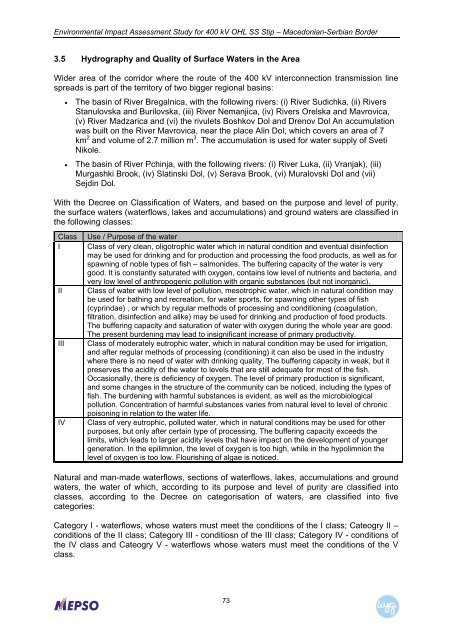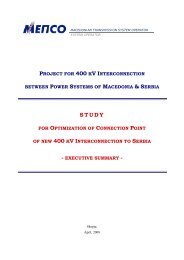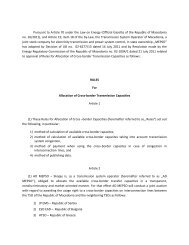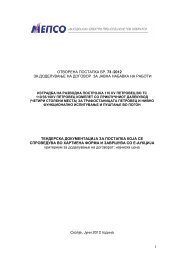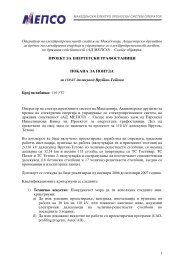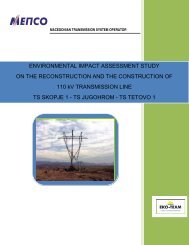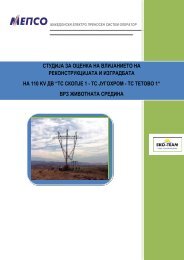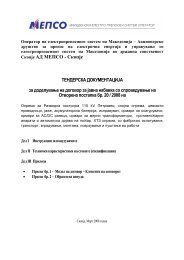Part A - EIA 400 kV OHTL Stp - мепÑо а.д.
Part A - EIA 400 kV OHTL Stp - мепÑо а.д.
Part A - EIA 400 kV OHTL Stp - мепÑо а.д.
Create successful ePaper yourself
Turn your PDF publications into a flip-book with our unique Google optimized e-Paper software.
Environmental Impact Assessment Study for <strong>400</strong> <strong>kV</strong> OHL SS Stip – Macedonian-Serbian Border3.5 Hydrography and Quality of Surface Waters in the AreaWider area of the corridor where the route of the <strong>400</strong> <strong>kV</strong> interconnection transmission linespreads is part of the territory of two bigger regional basins:• The basin of River Bregalnica, with the following rivers: (i) River Sudichka, (ii) RiversStanulovska and Burilovska, (iii) River Nemanjica, (iv) Rivers Orelska and Mavrovica,(v) River Madzarica and (vi) the rivulets Boshkov Dol and Drenov Dol An accumulationwas built on the River Mavrovica, near the place Alin Dol, which covers an area of 7km 2 and volume of 2.7 million m 3 . The accumulation is used for water supply of SvetiNikole.• The basin of River Pchinja, with the following rivers: (i) River Luka, (ii) Vranjak), (iii)Murgashki Brook, (iv) Slatinski Dol, (v) Serava Brook, (vi) Muralovski Dol and (vii)Sejdin Dol.With the Decree on Classification of Waters, and based on the purpose and level of purity,the surface waters (waterflows, lakes and accumulations) and ground waters are classified inthe following classes:ClassIIIIIIIVUse / Purpose of the waterClass of very clean, oligotrophic water which in natural condition and eventual disinfectionmay be used for drinking and for production and processing the food products, as well as forspawning of noble types of fish – salmonides. The buffering capacity of the water is verygood. It is constantly saturated with oxygen, contains low level of nutrients and bacteria, andvery low level of anthropogenic pollution with organic substances (but not inorganic).Class of water with low level of pollution, mesotrophic water, which in natural condition maybe used for bathing and recreation, for water sports, for spawning other types of fish(cyprindae) , or which by regular methods of processing and conditioning (coagulation,filtration, disinfection and alike) may be used for drinking and production of food products.The buffering capacity and saturation of water with oxygen during the whole year are good.The present burdening may lead to insignificant increase of primary productivity.Class of moderately eutrophic water, which in natural condition may be used for irrigation,and after regular methods of processing (conditioning) it can also be used in the industrywhere there is no need of water with drinking quality, The buffering capacity in weak, but itpreserves the acidity of the water to levels that are still adequate for most of the fish.Occasionally, there is deficiency of oxygen. The level of primary production is significant,and some changes in the structure of the community can be noticed, including the types offish. The burdening with harmful substances is evident, as well as the microbiologicalpollution. Concentration of harmful substances varies from natural level to level of chronicpoisoning in relation to the water life.Class of very eutrophic, polluted water, which in natural conditions may be used for otherpurposes, but only after certain type of processing. The buffering capacity exceeds thelimits, which leads to larger acidity levels that have impact on the development of youngergeneration. In the epilimnion, the level of oxygen is too high, while in the hypolimnion thelevel of oxygen is too low. Flourishing of algae is noticed.Natural and man-made waterflows, sections of waterflows, lakes, accumulations and groundwaters, the water of which, according to its purpose and level of purity are classified intoclasses, according to the Decree on categorisation of waters, are classified into fivecategories:Category I - waterflows, whose waters must meet the conditions of the I class; Cateogry II –conditions of the II class; Category III - conditiosn of the III class; Category IV - conditions ofthe IV class and Cateogry V - waterflows whose waters must meet the conditions of the Vclass.73


